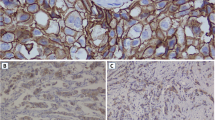Abstract
Background
Breast cancer is the commonest cancer among Sri Lankan women. The aim of this study was to document the breast cancer profile of a group of Sri Lankan women and compare it with regional data. Patient-tumor characteristics and predicted prognosis are compared with the immune profile.
Methods
A total of 814 Sri Lankan women with breast cancer were studied, with their information retrieved from patient records. Tumor type and grade were reassessed on routine tissue sections. The Nottingham Prognostic Index (NPI) was calculated. Estrogen receptors (ER) and human epidermal receptor 2 (HER2) were assessed using Dako antibodies. Strong nuclear staining for ER in >10% of tumor cells and strong, complete cell membrane staining (3+) for HER2 were regarded as positive. An SPSS-16 software program and the chi-squared test were used for statistical analysis.
Results
The highest prevalence (32%) was in the 50- to 59-year age cohort (mean ± SD 51.88 ± 11.939 years). In all, 58% of the tumors measured between 2 and 5 cm. Most (52%) were moderately differentiated and were invasive ductal carcinomas (86.3%). Regional lymph node metastasis was present in 41% of the patients. ER was expressed in 31.7% and was more frequent in women >35 years (p < 0.024). HER2 was found in 14.5% of tumors. Its expression was lower in ER-positive tumors (p < 0.000). Well-differentiated tumors were frequently ER-positive (p < 0.000) and HER2-negative (p < 0.001). The NPI was better for ER-positive (p < 0.000) and HER2-negative tumors (p < 0.028).
Conclusions
The overall profile of breast cancer and immune characteristics of Sri Lankan women in this study was largely comparable to profiles documented elsewhere in the region despite the lower prevalence of ER.

Similar content being viewed by others
References
Kelsey JL, Horn-Ross PL (1993) Breast cancer: magnitude of the problem and descriptive epidemiology. Epidemiol Rev 15:7–16
Anonymous (2000) Cancer Registry 2000. Cancer Control Programme. Cancer Institute, Maharagama, Sri Lanka
United Nations (2002) Department of Economic and Social Affairs Population Division. World Population Aging 1950–2050. United Nations Publications, New York
Fletcher CDM (2007) Diagnostic histopathology of tumours, 3rd edn. Churchill Livingstone, New York, pp 950–951
Malik IA (2002) Clinico-pathological features of breast cancer in Pakistan. J Pak Med Assoc 52:100–104
Thike AA, Chng MJ, Fook-Chong S et al (2001) Immunohistochemical expression of hormone receptors in invasive breast carcinoma: correlation of results of H-scores with pathological parameters. Pathology 33:21–25
Lertsanguansinchai P, Chottetanaprasith T, Chatamra K et al (2002) Estrogen and progesterone receptors status in Thai female breast cancer patients: an analysis of 399 cases at King Chulalongkorn Memorial Hospital. J Med Assoc Thai 85:193–202
Greenall MJ (2000) Cancer of the breast. In: Morris PJ, Wood WC (eds) Oxford textbook of surgery, 2nd edn. Oxford University Press, Turin, pp 1191–1223
Ellis IO, Galea M, Broughton N et al (1992) Pathological prognostic factors in breast cancer: relationship with survival in a large study with long term follow up. Histopathology 20:479–489
Pinder SE, Ellis IO, Elston CW (1995) Prognostic factors in primary breast cancer. J Clin Pathol 48:981–983
Grann VR, Troxel AB, Zojwalla NJ et al (2005) Hormone receptor status and survival in a population-based cohort of patients with breast carcinoma. Cancer 103:2241–2251
Allred DC, Harvey JM, Berardo M et al (1998) Prognostic and predictive factors in breast cancer by immunohistochemical analysis. Mod Pathol 11:155–168
Burstein HJ (2005) The distinctive nature of HER2 positive breast cancers. N Engl J Med 353:1652–1654
Ariga R, Zarif A, Korasick J et al (2005) Correlation of HER-2 neu gene amplification with other prognostic and predictive factors in female breast carcinoma. Breast J 11:278–280
Slamon DJ, Godolphin W, Jones LA et al (1989) Studies of the HER-2 neu proto-oncogene in human breast and ovarian cancer. Science 244:707–712
Desai SB, Moonim MT, Gill AK et al (2000) Hormone receptor status of breast cancer in India: a study of 798 tumours. Breast 9:267–270
Aryandono T, Harijadi, Ghozali A (2000) Corelation of clinical, pathological status, hormone receptor status and c-erb-b-2 oncoprotein in breast cancer patients. Gan To Kagaku Ryoho 27:600–606
Navani S, Bhaduri AS (2005) High incidence of oestrogen receptor negative progesterone receptor positive phenotype in Indian breast cancer: fact or fiction? Indian J Pathol Microbiol 48:199–201
Ross JR, Linette GP, Stec J et al (2004) Breast cancer biomarkers and molecular medicine. II. Expert Rev Mol Diagn 4:169–188
Redkar AA, Kabre SS, Mittra I (1992) Estrogen and progesterone receptors measurement in breast cancer with enzyme-immunoassay and correlation with other prognostic factors. Indian J Med Res 96:1–8
Fatima S, Faridi N, Gill S (2005) Breast cancer: steroid receptors and other prognostic indicators. J Coll Physicians Surg Pak 15:230–233
Acknowledgment
The initial part of this study was funded by National Science Foundation Sri Lanka grant RG/97/M4.
Author information
Authors and Affiliations
Corresponding author
Additional information
The initial findings of this study have been presented at several scientific sessions/meetings: Annual Academic Sessions of College of Surgeons of Sri Lanka and the 2nd International Conference of the SAARC Surgical Care Society, August 2003, Kandy, Sri Lanka; 114th Annual Academic Sessions of the Sri Lanka Medical Association, March 2001; 39th World Congress of Surgery of the International Society of Surgery, August 2001, Brussels, Belgium; 115th Annual Academic Sessions of the Sri Lanka Medical Association, March 2002.
Rights and permissions
About this article
Cite this article
Lokuhetty, M.D.S., Ranaweera, G.G., Wijeratne, M.D.M. et al. Profile of Breast Cancer in a Group of Women in a Developing Country in South Asia: Is There a Difference?. World J Surg 33, 455–459 (2009). https://doi.org/10.1007/s00268-008-9860-x
Published:
Issue Date:
DOI: https://doi.org/10.1007/s00268-008-9860-x




